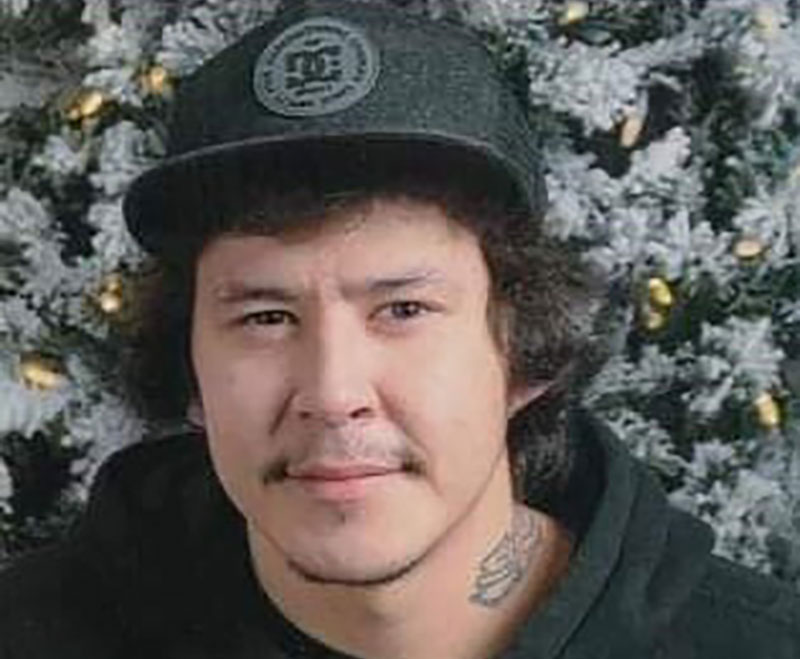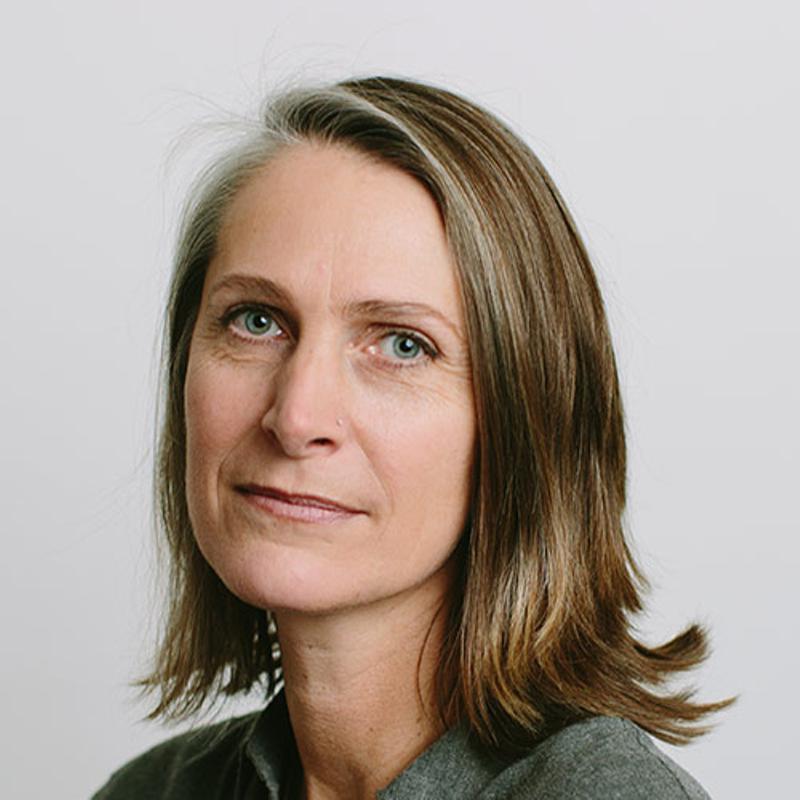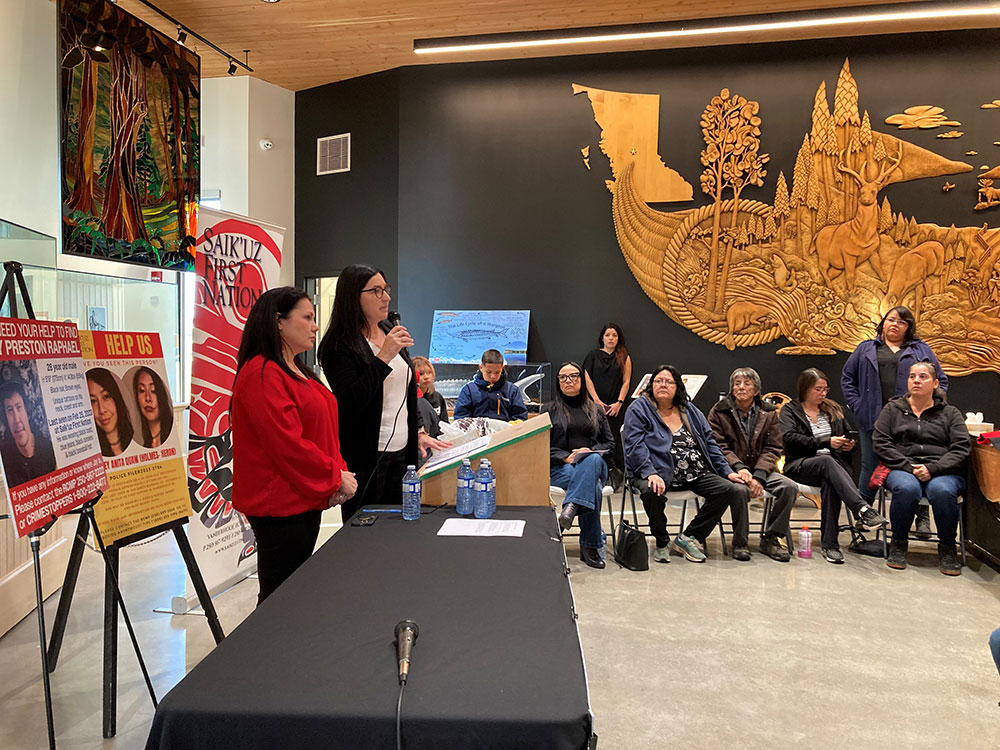Last week, as Pam Heron gave a tearful plea for information about her missing daughter, Chelsey, she already knew something was terribly wrong.
“She would have contacted me by now if she could. This is not like Chelsey. She loves her family deeply and she would never leave us this long without telling us,” Heron told dozens of people who gathered in Vanderhoof to hear from families of two missing Saik’uz First Nation community members.
Heron described the 29-year-old as independent, educated, hard-working and deeply loved. She embraced her culture and enjoyed nature by walking her dog, she said.
But when Chelsey Heron, who also goes by Quaw, walked away from her home on the Saik'uz First Nation in the early morning of Oct. 11, it was highly unusual, her mother said. For nearly four weeks, community volunteers and Nechako Valley Search and Rescue combed the northern B.C. reserve and nearby communities.
On Monday, Chelsey’s remains were found in a wooded area not far from her home. In a statement issued the same day, her mother said the family will not rest until they get answers. RCMP and the BC Coroners Service both say they are investigating.
Chelsey is the second Saik'uz member to go missing this year. In February, Jay Raphael also walked away from his house in the same community, home to about 400 people, and has not been seen since. Like Chelsey, his family says his disappearance is unusual.
“In both of these cases, their disappearance is out of character and cause for concern,” Saik'uz Chief Prescilla Mueller said at the Nov. 3 gathering. The nation called on the public for more information, the RCMP to step up its response and for more community volunteers to help search for information.

Immediately following Chelsey’s disappearance, search and rescue spent nearly a week combing the area. They returned on several of the following weekends. Searches have also taken place in Vanderhoof, 15 minutes away, and Prince George, an hour to the east, Mueller said.
“I just can’t say enough about all the volunteers who came from all over B.C. to help join in the search,” Mueller said. “I feel like there’s only so much that the local RCMP can do in the search. I feel like we need more support higher than just the local RCMP.”
Last week, Saik'uz council met with B.C.'s Attorney General Niki Sharma in Vancouver. In response to The Tyee’s request for comment, Public Safety Minister Mike Farnworth said in a statement that he is “deeply saddened” to learn about Chelsey’s death but could not comment on specifics of the ongoing police investigation.
“What I can say is, our government has implemented a number of measures to deal with missing person cases, including the establishment of provincial policing standards on missing person investigations and additional tools for police under the Missing Persons Act to assist with these types of investigations," Farnworth said.
He also acknowledged that more work needs to be done and that the province needs to "continue working with First Nation communities and public safety partners to ensure all tools are made available to respond to reports of missing persons." *
Those who spoke in Vanderhoof last week said they would like to see police doing more in a region that has seen a high number of Indigenous community members, many of them women and girls, go missing. Saik'uz is 15 kilometres south of Highway 16 and the 725-kilometre section of highway that stretches between Prince George and Prince Rupert, known as the Highway of Tears.
“Here it is, almost 20 years later, and I find myself saying the same things to the media,” said Mary Teegee, who helped organize the Highway of Tears Symposium in 2006, to The Tyee. “I think that, talking with the family, there definitely should have been a quicker response and a more fulsome response.”
Teegee, the executive director for Carrier Sekani Family Services, has spent years advocating for the safety of Indigenous women, girls and Two-Spirit people along the Highway of Tears corridor.
She called on RCMP to react faster to missing persons reports, adding that it took police a week to check Chelsey’s phone and bank records. The media also need to take disappearances more seriously, she said.
Among the 33 recommendations that came out of the Highway of Tears symposium was a call for an emergency readiness plan with a missing person alert-and-response component. More recently, the National Inquiry into Missing and Murdered Indigenous Women and Girls, in its 231 Calls for Justice, called on police to establish standardized response times for reports of missing Indigenous people.
The federal New Democrats have been pushing the Canadian government to implement Red Dress Alerts. Similar to Amber Alerts, which are used when children go missing, the Red Dress Alert would notify the public when an Indigenous woman, girl or Two-Spirit person goes missing.
This spring, the House of Commons adopted a motion by NDP MP Leah Gazan calling on the government to declare ongoing violence against Indigenous women, girls and Two-Spirit people a national emergency. It also called for “immediate and substantial investment” into the Red Dress Alert system.
While the federal government committed to exploring the system in this year’s budget, there is no timeline on moving it ahead, Skeena-Bulkley Valley MP Taylor Bachrach told The Tyee.
“We know that the first 24 hours are critical and that’s very much the idea behind the Red Dress Alert,” he said. “It increases quite dramatically the chances of people being found.”
Bachrach is currently launching a campaign to raise awareness for implementing Red Dress Alerts. He called Chelsey’s death “heartbreaking” and a “tragic reminder of how little progress has been made on the national inquiry’s calls for justice.”
Teegee also acknowledged that many Indigenous men go missing. She blamed the stigmatization of Indigenous people. “There has to be the same concerted effort for any Indigenous person that goes missing as there would be for a non-Indigenous woman or man,” she said.
Angie Raphael describes her 28-year-old son, Jay Raphael, as “the most kind-hearted, hard-working person I ever knew.” She remembers the day he walked away from the home they shared on the outskirts of the Saik'uz First Nation earlier this year.
“He told us that he’s coming back. We haven’t seen him since,” she said.

She added that Jay, who has a large extended family and two young children, would never have disappeared for nearly nine months without being in touch.
“He’s really family-oriented and nobody’s heard from him, none of his friends. Nobody. Like he vanished off the face of the earth,” she said.
The RCMP launched an investigation following Jay’s disappearance on Feb. 25, but they eventually ran out of leads, Raphael said. The investigation is now paused as police await new information. “To me, it’s like they gave up,” she said.
Raphael expressed gratitude for the community support she’s received but called on the public to come forward with any new information that could restart the investigation.
“Even if it’s something they don’t think is important, it might be,” she said. “It might be the thing that breaks this whole case open.”
Saik'uz First Nation is encouraging anyone with information about either case to contact the Vanderhoof RCMP at 250-567-2222 or provide anonymous tips to Crimestoppers at 1-800-222-8477.
* Story updated on Nov. 9 at 9:51 a.m. to include comment from B.C.'s Public Safety Ministry received after deadline. ![]()
Read more: Indigenous, Rights + Justice

















Tyee Commenting Guidelines
Comments that violate guidelines risk being deleted, and violations may result in a temporary or permanent user ban. Maintain the spirit of good conversation to stay in the discussion and be patient with moderators. Comments are reviewed regularly but not in real time.
Do:
Do not: